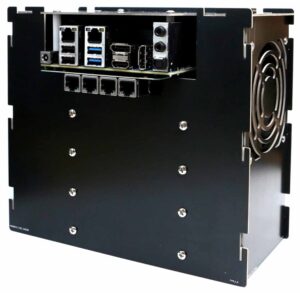I have gone through a lot of evolution of computer technology over the years, not only the technology, but my thinking. I remember my first server, which doubled as a NAS. It was a yellow full tower server system and had wheels . Why yellow? It was really inexpensive. But it was also really overbuilt for what I needed. I never filled all the bays and I never used it to its full capacity. And technology changed. I started building smaller, rather than overbuilding. I’ve gone from desktop, to laptop, to small PC, to mini PC, which is an evolution conversation in itself.
When my home built NAS died in the middle of the night some years ago, I ran to the store and bought a commercial NAS, because I was at the point in my life where I didn’t want to deal with another home build. So I went with a NAS and then a dedicated home server next to the NAS. And that was partly because the commercial NAS software was limiting and the manufacturer has stopped updating my model, but also because the hardware in NASes is always behind what you can get if you build it yourself. So, by investing in a NAS case, a motherboard, and using open-source, I can in future swap out the motherboard, upgrade the RAM, etc and continue…provided I keep to the same software platform.The lifespan is much longer.
I could run all my applications on the NAS, especially with the new hardware, but I want something that acts like an appliance…something that only is storage and storage related functions. I don’t want to clutter it with other things, even though it means another system to run server functions. Last time, I installed Linux and configured it. But there is software to make a computer a dedicated appliance, so it eliminated all the work I had to do to get everything working.
There are three popular options for NAS software…TrueNAS, Unraid, and OpenMediaVault.
TrueNAS has a commercial and a community version. It comes in the classic Core version, based on FreeBSD and the newer Linux based Scale. I get the impression impression Scale is the future for the project. Scale allows for containers and virtual machines if you want to run your applications on top of it. For the drives, it offers ZFS and the ability to deploy object storage similar to Amazon’s S3. ZFS is an incredibly robust filesystem.
Unraid, by comparison, is also commercially supported, with a license cost of $49 to $249, which includes the software. The most expensive membership at $249 is lifetime, which means updates for life, and the others offer updates for a year with a fee to upgrade after that. Even with no updates, some security patches are still offered for the older versions. The advantage of Unraid is it can manage drives that vary in size, speed, brand, and filesystem…so no RAID technology. Instead, it uses a dedicated parity drive, and offers a cache drive for speed.
Openmediavault is somewhere closer to Unraid in its simplicity, but has no commercial cost. It seems to be in the middle of the option here and can veer toward the Unraid feature set or the TrueNAS ones.
I ended up with TrueNAS, because I wanted the features it offered for data storage. I’ll be talking more about that, but setting it up took more time to restore my data than it did to set it up. It is now handling 100% of the file serving the previous server did. I still have backup and other redundancy functions to configure, but I’m 100% back online.
